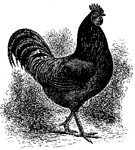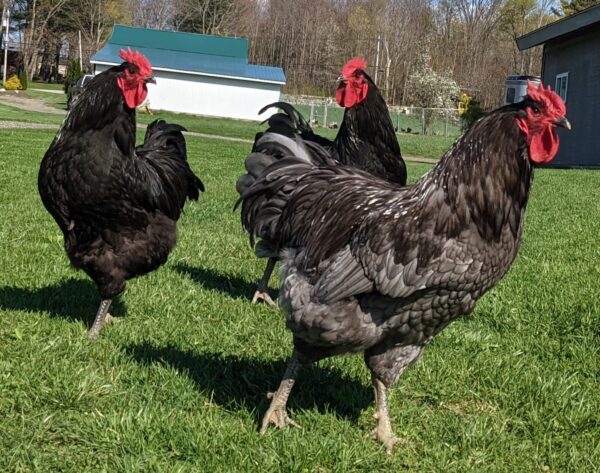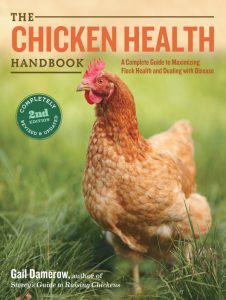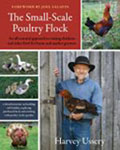
Breed Facts
Status:
Recovering
Use:
Eggs, Meat
Egg Color:
Light Cream to Dark Brown
Egg Size:
Extra Large
Weight:
Male 13-15 lbs. / Female 10-11 lbs.
Temperament:
Calm, Friendly
Characteristics:
Size
JERSEY GIANT CHICKEN
The Jersey Giant chicken was developed between 1870 and 1890 by John and Thomas Black in Burlington County, New Jersey, near the town of Jobstown. The original intention of the Black brothers was to create a chicken that could potentially replace turkeys as a premium table bird. During the breed’s development, Black Javas, Black Langshans, and Dark Brahmas were used to try to reach this goal. Around 1895, the term “Giant” was used to reference the breed and they became known as “Black Giants” in honor of their creators – not because of their color. Dexter P. Upham of Belmar, NJ, an early breeder interested in improving the breed, changed the name to “Jersey Giant.”
In 1921, the American Association of Jersey Black Giant Breeders Clubs was created, and the name “Jersey Giant” was officially adopted by the group. The standard developed for the birds included a gigantic frame, single comb, yellow skin color, relatively rapid maturity, good vigor, and fine foraging ability. They have a medium to long body that is wide and deep, and so they can look like a square bird. Their back is flat, and their tail appears relatively short.
The Jersey Giant was recognized by the American Poultry Association (APA) Standard of Perfection in 1922. The white was recognized in 1947 and the blue in 2003. So today, Jersey Giants are accepted in the APA in three color varieties – black, white, and blue.
As its name implies, these typically mellow chickens are impressive in size with mature roosters weighing 13-15 lbs. and the mature hens weighing 10-11 lbs., however, the black variety is about a pound heavier than the white variety upon maturity. Male birds stand 22-26 inches and the females 16-20 inches – the Giant is a BIG bird!
Black birds have a “beetle green” sheen which is very attractive. Legs are black with yellow feet soles and four toes on each foot. They do not have leg feathering. They have a red single come and red wattles, brown eyes and a black beak that may has a little yellow at the tip. White birds have willow-colored shanks, with yellow soles. Their beak is more yellow. The blue variety has nearly black or dark willow shanks, and their feathering is a slatey-blue with darker blue lacing.
Jersey Giants are dual-purpose chickens, but they excel as meat birds with their body size. They are well-suited to producing very fine and large capons, and are an excellent roasting bird when fully mature. Their meat is reportedly excellent, and one bird can feed a family of four. The young birds grow relatively quickly, but most take up to 8 to 9 months to reach a harvestable size with good body proportions. Although they can produce a lot of meat per bird, they are a slow-growing breed, and they have poor feed-to-meat conversion, so they must eat a lot of food to get them to a harvestable weight.
The hens of this breed tend to lay more eggs than other heavy breeds. Their eggs are extra-large in size with colors ranging from dark brown to light cream, and they lay about 150-200 eggs per year. Some Jersey Giant hens go broody and some do not, so you need to check with the source where you buy them if you are specifically interested in broody or non-broody birds. They are good mothers, but they can have problems with setting due to their weight, as they can crush their eggs. When incubating eggs, the Jersey Giant breed sometimes takes 1 to 2 days longer to hatch than those of other chicken breeds. They start to lay between 8 months and a year of age, though some owners have reported their hens laying at 5 months.
Jersey Giants are a very cold-hardy breed, but the large single combs on the roosters can be subject to frostbite. Jersey Giants generally lay during the winter. However, they do not do well in the heat, so they must have options to keep them cool in warm climates.
They are a hardy breed, and they love to forage. They do well against predators, although the black and blue varieties do better than the white variety. Because they are large, some will fight potential aggressors. They are calm and docile and get along with other chicken breeds, and some Jersey Giants are tolerant of other roosters. They generally don’t fly because of their weight, but some have been known to fly over a fence if something attracts them. They are friendly birds and many like to cuddle with their owners.
Because they are larger than other breeds, you will need to make modifications to your coop to accommodate them. They need larger nesting boxes, more space on their roosting bars, and bars should be lower because they can injure their legs jumping down from higher ones. Although they are an overall healthy breed, due to their weight, if there is anything sharp under the perch and the bird lands on it and injures its foot, the bird becomes susceptible to bumblefoot and possibly death.
The breed can be noisy and may not be a good choice if you have close neighbors. However, they can be a good option if you have plenty of grazing area.
Did you know:
When farms and farmers face a crisis, rare livestock breeds are more likely to be lost. That’s why The Livestock Conservancy offers Emergency Microgrants year-round. As the economy tightens, off-farm jobs are lost, herds are downsized, veterinary emergencies happen, and calamities such as floods, fires, and tornadoes continue. Help us help them. Click here to support the Emergency Response Fund with your gift today.
You may be interested in…

Breed Facts
Status:
Recovering
Use:
Eggs, Meat
Egg Color:
Brown
Egg Size:
Extra Large
Market Weight:
8 – 11 lbs
Temperament:
Calm
Characteristics:
Size
You may be interested in…




